Volkswagen Group Bundle
Who Really Controls Volkswagen?
Understanding the Volkswagen Group SWOT Analysis is crucial, but have you ever wondered who truly steers this automotive giant? The ownership of Volkswagen, a titan in the global market, is far more intricate than meets the eye. Unraveling the Volkswagen ownership structure reveals a fascinating story of strategic maneuvers, historical legacies, and significant market influence. Knowing who owns Volkswagen is key to grasping its future direction.
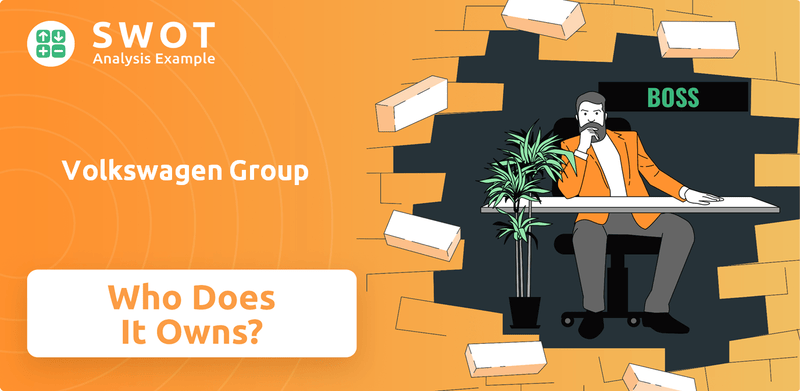
This exploration into VW Group owner will dissect the Volkswagen AG ownership, from its founding to its present-day composition. We'll examine the roles of key Volkswagen shareholders, major stakeholders, and the dynamics of the Volkswagen parent company. Knowing who owns Audi and who owns Porsche is just the beginning; we'll delve into the complex web of subsidiaries and the evolving landscape of Volkswagen stock ownership breakdown, offering insights for investors and analysts alike.
Who Founded Volkswagen Group?
The genesis of Volkswagen, a cornerstone of the global automotive industry, traces back to May 28, 1937. It was established by the German Labour Front (Deutsche Arbeitsfront), acting as a state-owned entity. Initially named Gesellschaft zur Vorbereitung des Deutschen Volkswagens mbH, the company later became known as Volkswagenwerk.
The original vision, conceived by Adolf Hitler, was to mass-produce an affordable 'people's car.' This concept was brought to life by Austrian automotive engineer Ferdinand Porsche. During its nascent phase, the company was entirely under state control, reflecting the political and economic landscape of the time.
Following World War II, the Volkswagen factory, which had been repurposed for wartime production, underwent reconstruction under British supervision. In 1949, the ownership of the company transitioned to the West German government and the state of Lower Saxony. This marked a significant shift from its origins as a Nazi-era state-owned enterprise to a model of joint control between the government and a regional state.
Volkswagen was initially a state-owned enterprise under the German Labour Front.
After the war, control shifted to the West German government and the state of Lower Saxony.
The foundational ownership was held by governmental entities.
The company remained under joint ownership of the West German government and the state of Lower Saxony until 1960.
The early history of Volkswagen ownership reveals a transition from complete state control to a model of joint ownership. Brief History of Volkswagen Group highlights the evolution of the company's ownership structure. The initial ownership structure was a direct reflection of the political environment, with the state playing a central role. This evolved post-war, setting the stage for the Volkswagen Group's future development. The company's ownership structure continued to evolve, leading to the current structure, where it is a publicly traded company with a complex shareholder base. The history of Volkswagen ownership is a critical aspect of understanding the company's evolution.
Volkswagen Group SWOT Analysis
- Complete SWOT Breakdown
- Fully Customizable
- Editable in Excel & Word
- Professional Formatting
- Investor-Ready Format
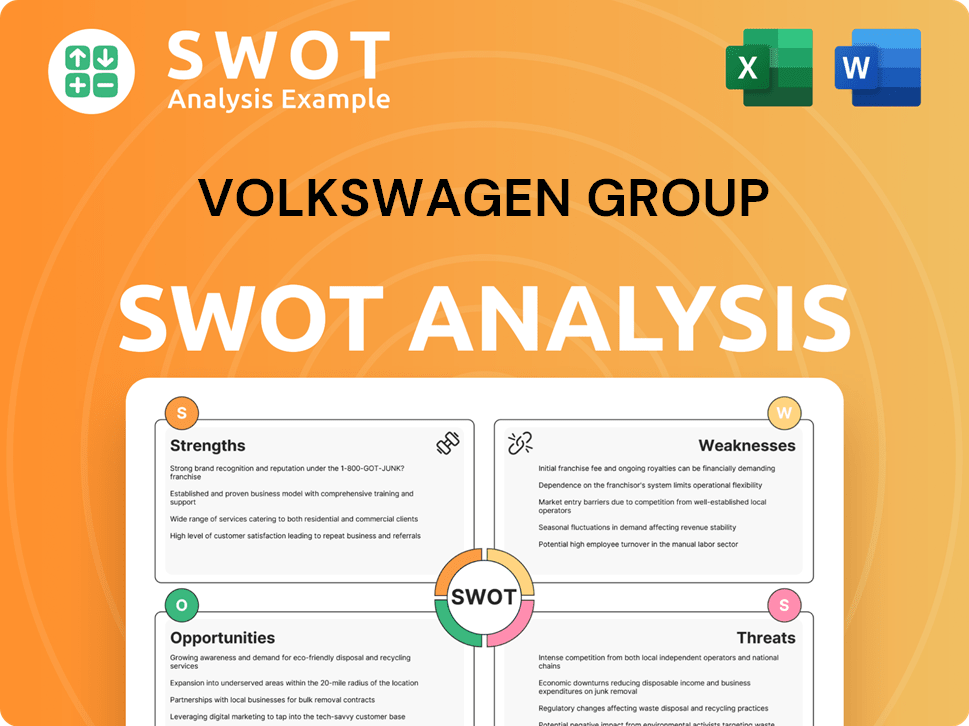
How Has Volkswagen Group’s Ownership Changed Over Time?
The evolution of Volkswagen's ownership has been marked by significant shifts since its inception. Initially, in 1960, the company underwent a denationalization process, with a portion of its shares offered to the public through an IPO. However, the Federal Republic of Germany and the State of Lower Saxony maintained substantial stakes, ensuring governmental influence. This initial structure set the stage for the complex ownership model that exists today, influencing the strategic direction and operational decisions of the company.
Over the years, the ownership structure of Volkswagen has evolved, with key players and their respective stakes changing. The most recent developments include the integration of Porsche AG and the influence of major shareholders like Porsche Automobil Holding SE, the State of Lower Saxony, and Qatar Holding LLC. These changes reflect the ongoing dynamics of the automotive industry and the strategic decisions made by the company's key stakeholders. Understanding the current Volkswagen ownership structure is essential for anyone interested in the company's future.
| Key Event | Date | Impact on Ownership |
|---|---|---|
| Initial Public Offering (IPO) | 1960 | 60% of shares sold to the public; Federal Republic of Germany and State of Lower Saxony retained 20% each. |
| Takeover of Porsche AG | 2012 | Porsche AG integrated as the 10th brand of Volkswagen. |
| Porsche AG IPO | September 2022 | Preferred shares of Porsche AG began trading on the Frankfurt Stock Exchange. Volkswagen Group sold 25% plus one ordinary share of Porsche AG to Porsche SE. |
As of December 31, 2024, the subscribed capital of Volkswagen AG totaled €1,283,315,873.28, divided into 295,089,818 ordinary shares and 206,205,445 preferred shares. Porsche Automobil Holding SE holds 53.3% of the voting rights, making it the largest shareholder. The State of Lower Saxony holds 20.0%, and Qatar Holding LLC holds 17.0%. The remaining 9.7% of ordinary shares are in free float. This structure highlights the significant influence of Porsche SE and the continued importance of governmental and institutional investors in shaping the company's direction. For a better understanding of the company's target audience, check out the Target Market of Volkswagen Group.
The ownership of Volkswagen is complex, with several key stakeholders influencing its strategic decisions. Porsche SE is the majority shareholder, while the State of Lower Saxony and Qatar Holding LLC also hold significant stakes.
- Porsche SE controls 53.3% of the voting rights.
- The State of Lower Saxony holds 20.0% of the voting rights.
- Qatar Holding LLC holds 17.0% of the voting rights.
- Remaining shares are in free float.
Volkswagen Group PESTLE Analysis
- Covers All 6 PESTLE Categories
- No Research Needed – Save Hours of Work
- Built by Experts, Trusted by Consultants
- Instant Download, Ready to Use
- 100% Editable, Fully Customizable
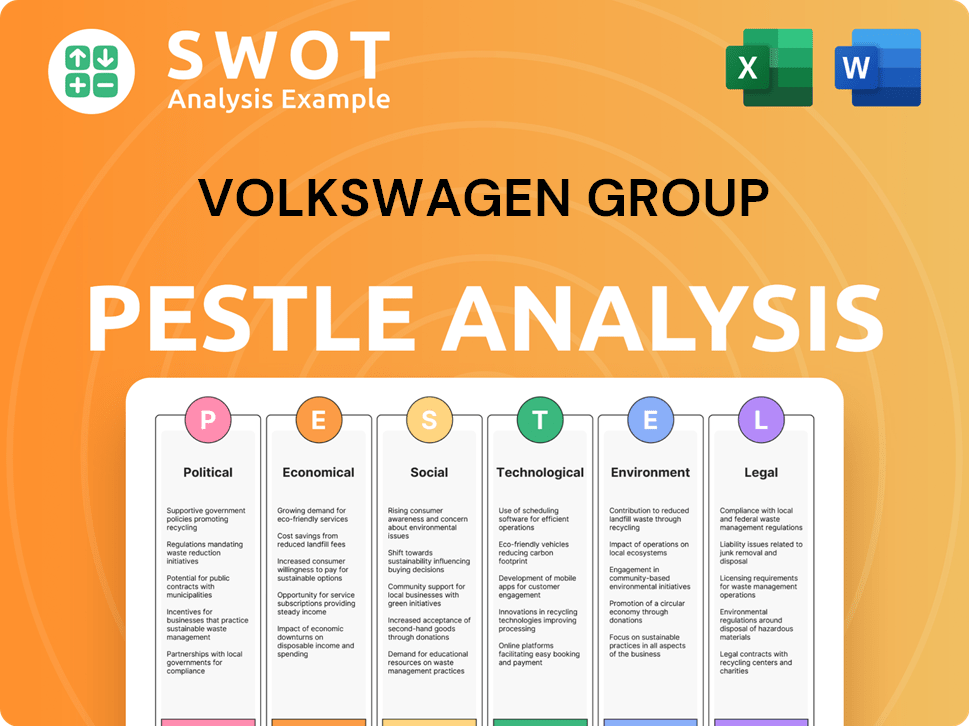
Who Sits on Volkswagen Group’s Board?
The governance structure of Volkswagen AG is a critical aspect of understanding the Volkswagen ownership. The company employs a two-tier board system, which is standard in Germany. This structure includes a Board of Management and a Supervisory Board. The Supervisory Board is composed of 20 members. Half of these members represent shareholders, while the other half represents employees. This setup ensures a balance of interests and perspectives in the company's strategic direction.
The State of Lower Saxony holds a significant position in the governance structure. By law, the state is entitled to appoint two members to the Supervisory Board, provided it holds at least 15% of Volkswagen AG's ordinary shares. This provision ensures that the state maintains a strong influence over the company's operations and long-term strategies. This is a key element in understanding the VW Group owner and the broader Volkswagen shareholders.
| Board Member | Role | Affiliation |
|---|---|---|
| Hans Dieter Pötsch | Chairman of the Supervisory Board | Porsche Automobil Holding SE |
| Oliver Blume | Chairman of the Board of Management (CEO) | Volkswagen AG |
| Wolfgang Porsche | Member of the Supervisory Board | Porsche and Piëch Families |
The voting structure at Volkswagen AG is based on a dual-class share system. Ordinary shares carry voting rights, while preferred shares typically do not. As of December 31, 2024, Porsche Automobil Holding SE holds 53.3% of the voting rights, which gives the Porsche and Piëch families substantial control over the company. The State of Lower Saxony holds 20.0% of the voting rights, and Qatar Holding LLC holds 17.0%. Resolutions at the Annual General Meeting that require a qualified majority need more than four-fifths (80%) of the represented share capital to pass. This gives the State of Lower Saxony a de facto veto right on major decisions due to its substantial voting stake. To learn more about the company's strategic direction, you can read about the Growth Strategy of Volkswagen Group.
Understanding the board structure and voting rights is crucial for anyone looking into Who owns Volkswagen.
- The Supervisory Board balances shareholder and employee interests.
- The State of Lower Saxony has significant influence due to its shareholding.
- Porsche Automobil Holding SE holds the majority of voting rights.
- Major decisions require a high threshold of approval, giving key stakeholders significant power.
Volkswagen Group Business Model Canvas
- Complete 9-Block Business Model Canvas
- Effortlessly Communicate Your Business Strategy
- Investor-Ready BMC Format
- 100% Editable and Customizable
- Clear and Structured Layout
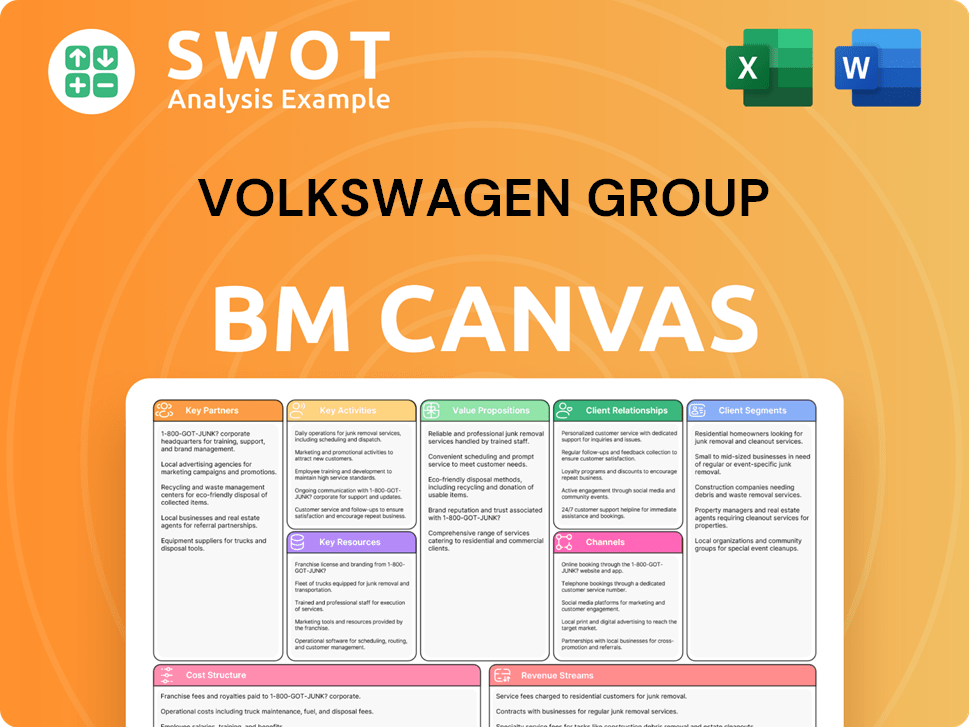
What Recent Changes Have Shaped Volkswagen Group’s Ownership Landscape?
Over the past few years, the Volkswagen Group has been navigating a dynamic automotive landscape. This includes significant shifts towards electrification and digitalization, driving the company's 'NEW AUTO' strategy and 'The Group Strategy – Mobility for Generations' roadmap up to 2035. This involves considerable investment in electric vehicle development, software capabilities through its subsidiary CARIAD, and battery cell production in Europe, with a goal of having six battery factories by 2030. The company aims for 70% of its sales in Europe to be electric by 2026.
Financially, the VW Group reported sales revenue of €324.7 billion in fiscal year 2024. Although this was a slight increase from 2023, the operating result in FY 2024 was €19.1 billion, a 15% decrease from FY 2023, with the operating margin at 5.9%. Projections for 2025 anticipate sales revenue to increase by up to 5%, with an operating return on sales between 5.5% and 6.5%.
| Ownership Aspect | Details | Impact |
|---|---|---|
| Porsche SE | Largest shareholder, holding a significant portion of voting shares. | Maintains long-term strategic influence and stability. |
| State of Lower Saxony | Significant shareholder, providing a degree of stability. | Protects against rapid activist investor campaigns. |
| Institutional Investors | Growing presence. | Reflects broader market trends. |
Recent ownership discussions in early 2025 included potential moves by Porsche SE, the VW Group owner, to sell some voting shares to raise capital. However, this was denied in March 2025, with Porsche SE reaffirming its commitment as a long-term anchor shareholder. The ownership structure, with the strong influence of the Porsche-Piëch families and the State of Lower Saxony, provides a degree of stability despite challenges like intense competition in China, where its market share fell to 14.5% in 2023, and a slowdown in European EV sales in Q1 2024. Volkswagen continues to invest in new models, with 30 planned for 2024, focusing on affordable electric cars by 2025, and is also facing pressure to reduce costs.
The primary stakeholders in Volkswagen include Porsche SE, the State of Lower Saxony, and various institutional investors.
The VW Group's structure is characterized by the strong influence of the Porsche-Piëch families and the State of Lower Saxony.
Key shareholders include Porsche SE, which is the majority shareholder, and the State of Lower Saxony.
The major stakeholders, Porsche SE and the State of Lower Saxony, play a key role in the long-term strategic direction of the company.
Volkswagen Group Porter's Five Forces Analysis
- Covers All 5 Competitive Forces in Detail
- Structured for Consultants, Students, and Founders
- 100% Editable in Microsoft Word & Excel
- Instant Digital Download – Use Immediately
- Compatible with Mac & PC – Fully Unlocked
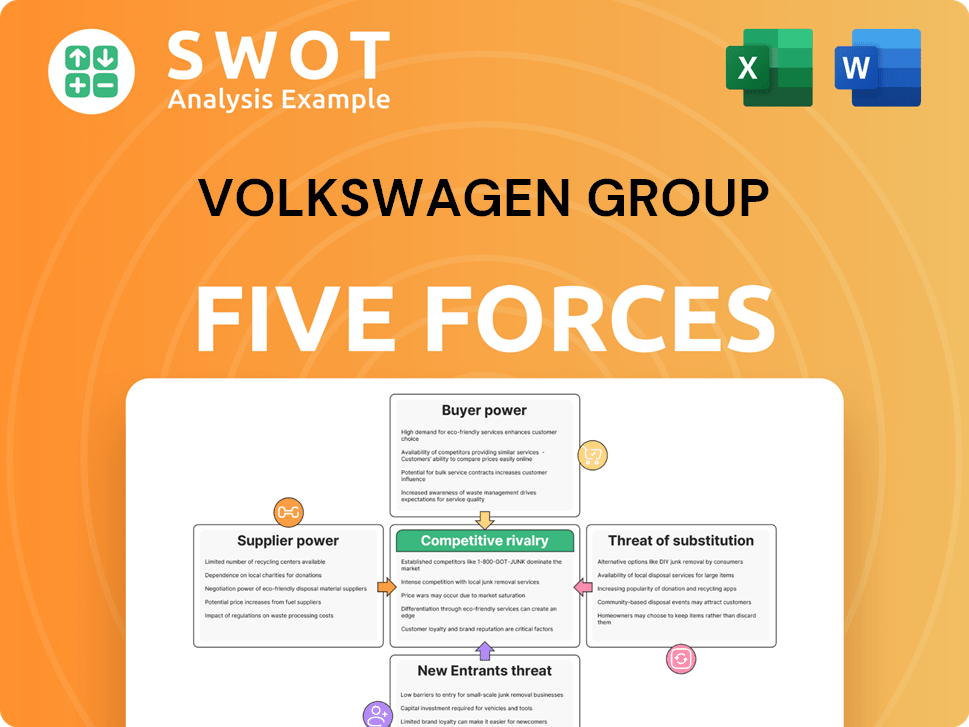
Related Blogs
- What are Mission Vision & Core Values of Volkswagen Group Company?
- What is Competitive Landscape of Volkswagen Group Company?
- What is Growth Strategy and Future Prospects of Volkswagen Group Company?
- How Does Volkswagen Group Company Work?
- What is Sales and Marketing Strategy of Volkswagen Group Company?
- What is Brief History of Volkswagen Group Company?
- What is Customer Demographics and Target Market of Volkswagen Group Company?
Disclaimer
All information, articles, and product details provided on this website are for general informational and educational purposes only. We do not claim any ownership over, nor do we intend to infringe upon, any trademarks, copyrights, logos, brand names, or other intellectual property mentioned or depicted on this site. Such intellectual property remains the property of its respective owners, and any references here are made solely for identification or informational purposes, without implying any affiliation, endorsement, or partnership.
We make no representations or warranties, express or implied, regarding the accuracy, completeness, or suitability of any content or products presented. Nothing on this website should be construed as legal, tax, investment, financial, medical, or other professional advice. In addition, no part of this site—including articles or product references—constitutes a solicitation, recommendation, endorsement, advertisement, or offer to buy or sell any securities, franchises, or other financial instruments, particularly in jurisdictions where such activity would be unlawful.
All content is of a general nature and may not address the specific circumstances of any individual or entity. It is not a substitute for professional advice or services. Any actions you take based on the information provided here are strictly at your own risk. You accept full responsibility for any decisions or outcomes arising from your use of this website and agree to release us from any liability in connection with your use of, or reliance upon, the content or products found herein.